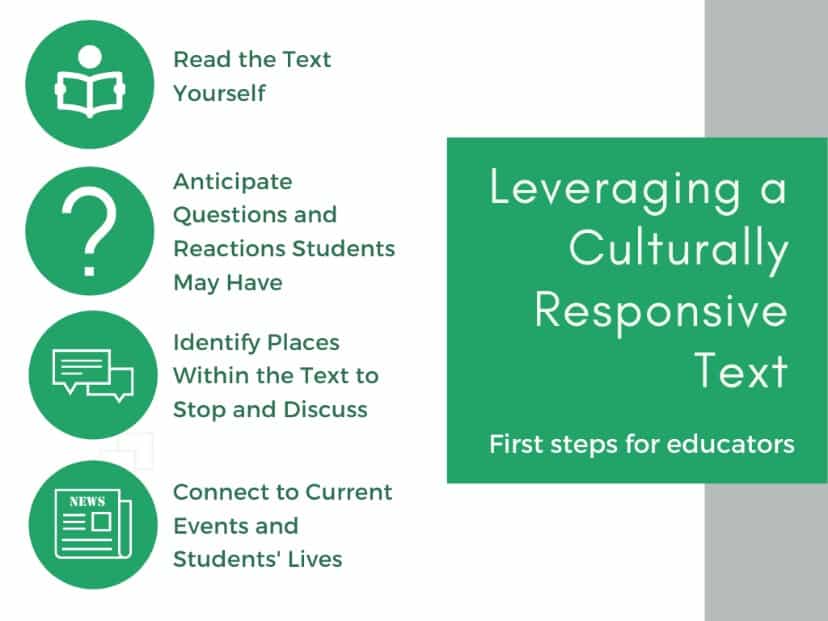The following is an interview with Keenan Lee, a first-grade teacher in an urban school district in Pennsylvania. In June of 2020, Keenan crowd-sourced an extensive, grade-band-specific list of culturally diverse texts (Culturally Diverse & LGBTQ+ Books for Prek-Higher Education)—reaching out to educators across the nation via social media. The list features titles for Pre-K students all the way through higher ed/adult reading. In this interview, Keenan shares recommendations for how to leverage these texts to provide powerful learning experiences for students.
Q: How would you describe the value culturally diverse texts bring to a classroom discussion? How do they support students’ growth?
A: When the teacher includes books that are culturally diverse, they are adding value through exposing their students to books that are written by someone who shares the same culture and traditions. Allowing students to explore books by someone who may look like them or share the same cultural background will develop more interest in reading, which will help academically in developing their literacy skills. Most importantly, for teachers of students who are predominantly white, it is important to expose the students to culturally diverse books because it will introduce the students to situations, traditions, and cultures that are not seen in their home lives or schools. When adding these books for the students, it will help students be more culturally aware and value how they see themselves, others, and their place in the world around them.
Q: Many teachers may be required to teach a certain curriculum with existing texts. Any suggestions for how to integrate new texts into the time they have with students each week?
A: I suggest that teachers should always find time to include a read-aloud of their choosing. It is important that, as teachers, we expose our students to authentic text that doesn’t come from a basal reader series. One way I incorporate culturally diverse books in my classroom is during the read-aloud at various times of the day. For example, we would read a book that my students or I have chosen. This takes place before or after lunch and again before the day’s special.
Q: There have been lots of great recommendations shared for culturally diverse texts—how do you, as the teacher, decide which ones to share and when?
A: To me, the hardest part is picking a book! There are so many great authors with so many great titles, and it is difficult to just pick one. In all seriousness, when I select books, I try to tie the book into the theme or unit that we are working on in English Language Arts. I found that many of my students have limited background knowledge when it comes to the stories in our reading curriculum, so I reinforce what we are learning by reading a culturally diverse book that the students can connect with. I love when I teach fairy tales and fables because there are so many different variations of popular stories from many different cultures, which makes the read-aloud and the discussion that follows it so much fun. I also try to base the stories that I choose around holidays and special events. One of my favorite stories I like to share around election time is Grace for President. This book shows students, especially female students, that they can be anything they want to be if they persevere and keep going.
Q: Walk us through some steps educators might take, once they have a text in hand, to design a lesson and discussion that leverages a culturally diverse text to its full potential.
A: The first thing I do when I pick out my story is to sit down and read the story myself. Sometimes I have to read the story twice to be sure I am understanding the messaging the author is trying to present. When reading the story myself I am able to put myself in my students’ shoes and jot down some questions they might have, and it also allows me to find stopping points in the book that will lend themselves to meaningful discussion. After reading the story, I then think about how I can tie the story back into current events. I always have to do reflection when trying to make the connection to the real world because it allows me to really think about how this will affect my students and how I can be open and honest with them without going too much into it. At the end of it all, I want to tie the lesson back into the story and allow students to make their own personal connections. Overall, I try to leave my students with something that they can relate to and understand.

Q: Discussions about the text have the potential to get heated, emotional, and personal. How do you create a safe space for everyone to feel comfortable digging into the text?
A: I have created a safe space in my classroom from the first time students enter the classroom—these rules don’t just apply to discussing culturally relevant texts. My main rule for discussions is that we do not make fun of, laugh at, or judge our friends. We are a family, and families lift and support each other through the good and the bad. I also show my students that sometimes I make mistakes, too, so I share my thoughts and feelings on topics. I think showing/modeling to the students how I react in certain situations really gives them an idea of how we successful have conversations within our classroom family.
Q: Do you have any specific advice for teachers of early elementary school students about facilitating activities?
A: I would tell other early elementary teachers to not hold back when facilitating these activities with their students. The discussions we have in our classroom, with our students, are the most meaningful and rich conversations that many of our students have with peers and adults. For example, to get the conversation started with my students in my classroom, I always ask the students how the characters feel in the story. After asking that question about the characters, I like to tie it back to the student. I proceed to ask the students, “If you were in the book, how would you feel if you were in the story and this is happening?” It is important to have this type of dialogue, especially at the early elementary level, because it allows students to work on understanding and practicing different social emotional skills. Oftentimes, we open the door for students to ask questions that sometimes their parents are not comfortable answering.
One activity that I like to do with my students to show cultural diversity is to read and discuss The Family Book by Todd Parr. After reading and discussing the story, I give each student a sheet of scrapbook paper and instructions for parents. With this activity the students and their family are tasked to create a family collage. On the collage, the students will include anything that makes up their family and how it makes them unique. For example, the students can draw or post pictures of their family members, favorite foods, activities, and other activities that they do together as a family. Once the students return the collage to school, all students have an opportunity to share their collage and what makes them special. As we share the collages with one another, the students are able to subconsciously compare and contrast the differences between their family and their peers. The goal of this activity is to allow students to see that we are all diverse and are unique in our own special way.
Q: Do you have any tips on advocating for inclusion of diverse texts with colleagues or administration who may be resistant to including them in their own instruction or facilitating schoolwide use?
A: As a teacher, we should use our voice to advocate for the inclusion of diverse text with colleagues and administration. One tip I suggest is bringing up why inclusion of these text is important during grade-level planning or PLC times. These are times when everyone can have a say and can express their point of view. I would also include solid research-based information to back your advocacy. Another tip I would suggest for teachers to do is to invite the administration and other colleagues into your classroom during one of your read-aloud times when you are using a diverse book. It is good for administration to see the meaningful conversations that you and your students have together. It is powerful when someone else can watch how the books lead and guide complex conversations.
Q: Where can readers go for more lesson-planning resources or additional ideas for texts?
A: I have included a few links. I go to these pretty frequently to check out new ideas.

















This is interesting and needed. As a long time teacher, we have not exposed students to news, and topics that impact their lives everyday.
Thank you for this thoughtful information and excellent resources! We are currently collating a list of books and I’ll be sure to include your recommendations- much appreciated!
Thank you for this thought provoking piece. I have debated exposing text to K-1 students about same sex relationships although some of our households do reflect such, and, now I am more comfortable in talking with administrators about integration of such in presentations. I am in the South, so although we know about “it”, we still hide or shy away from “it” (what is not “normal” relationships)